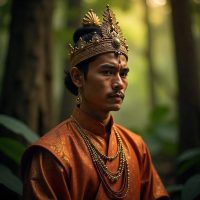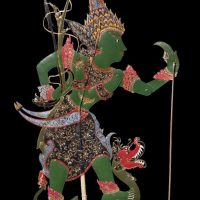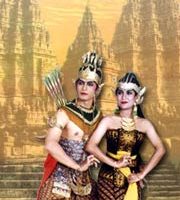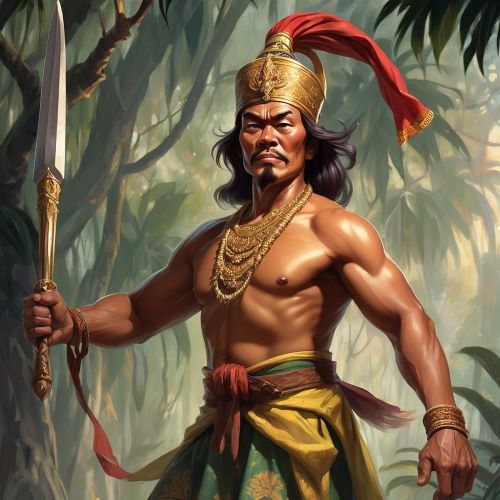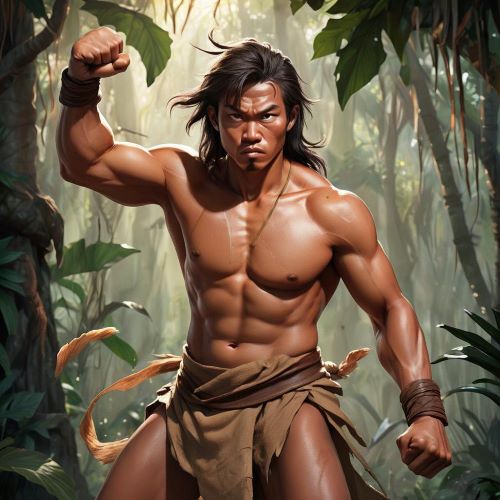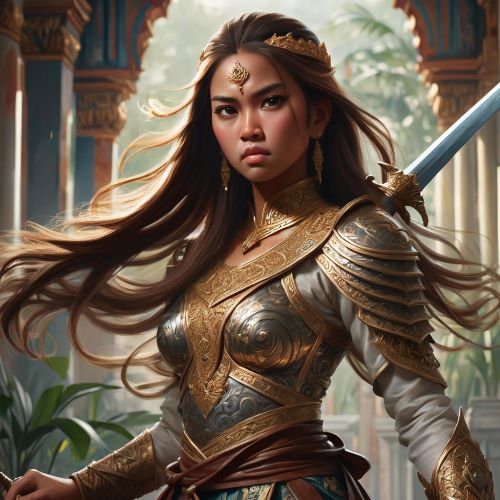Seri Rama : The Legendary Hero of the Malay World
Listen
At a glance
| Description | |
|---|---|
| Origin | Malaysian Mythology |
| Classification | Mortals |
| Family Members | Raja Dasarata (Father), Shanta (Sister), Baradan (Brother), Sita Dewi (Wife) |
| Region | Malaysian |
| Associated With | Royalty, Warrior |
Seri Rama
Introduction
Seri Rama stands at the heart of Hikayat Seri Rama, a monumental work in the Malay literary tradition that reshapes the ancient Ramayana into a distinctly Malaysian epic. While the Indian Rama embodies the classical avatar of Vishnu, the Malay adaptation places Seri Rama within an Islamic and local cultural framework, portraying him as a descendant of Prophet Adam and a ruler whose decisions reflect the moral and diplomatic values idealised in Malay court society. Over centuries, storytellers, scribes, and puppeteers have moulded the narrative into a uniquely Southeast Asian tale, blending spiritual ideas, ethical teachings, and local aesthetics. Wayang kulit performances, manuscripts, and modern reinterpretations continue to preserve the story, demonstrating how Seri Rama remains one of Malaysia’s most enduring cultural icons.
Physical Traits
In Malay representations, Seri Rama is visually different from his Indian counterpart. Instead of the blue-skinned divinity seen in many Indian traditions, he is portrayed with a golden or light complexion, reflecting local artistic sensibilities. His appearance is refined and harmonious, with a poised expression, elongated features, and a regal profile that emphasises calmness and inner discipline. Wayang kulit puppets often depict him with delicate carvings, narrow eyes, and a posture that conveys nobility rather than aggression. These artistic details communicate the Malay ideal of the raja putera: a prince who inspires loyalty not through brute strength but through composure, dignity, and moral excellence.
Family
Family ties form the emotional foundation of the Seri Rama narrative. As the eldest son of Raja Dasarata, whose lineage is traced to Prophet Adam in Malay texts, Seri Rama inherits a responsibility shaped by moral legitimacy and spiritual ancestry. His brother Baradan—adapted from Laksmana—emerges as his closest companion, known for unwavering loyalty and decisive action. Sita Dewi, his wife, symbolises integrity and constancy, but her role is framed within Malay portrayals of feminine virtue and resilience. A distinctive feature of the Malay adaptation is the prominence of Shanta, Seri Rama’s sister, whose abduction by Maharaja Wana sets the conflict in motion. This narrative shift highlights familial bonds and the value placed on protecting kin, shaping the epic into a story that foregrounds unity, honour, and reconciliation.
Other names
The story of Seri Rama travelled widely across Southeast Asia, resulting in numerous regional names and adaptations. In Malay literature, “Seri Rama” is the preferred title, distinguishing the character from the Indian “Sri Ram” while emphasising his integration into Malay culture. Variants such as “Rama” and “Sri Rama” appear in older manuscripts, reflecting the story’s Indian roots, while Southeast Asian neighbours use names such as Phra Ram in Thailand and Phra Lak Phra Lam in Laos. These variations demonstrate how the hero’s identity evolved as the narrative crossed borders, absorbing language, religion, and artistic styles unique to each region.
Powers and Abilities
Although Seri Rama retains divine qualities associated with the Ramayana, Malay adaptations focus more on his judgement, humility, and wisdom than on supernatural feats. His martial skills remain exceptional—he wields celestial weapons, commands strategic warfare, and displays mastery in archery—but these strengths are balanced by his preference for negotiation and moral reasoning. The Hikayat emphasises moments where Seri Rama chooses counsel over conflict, reflecting Malay ideals of diplomacy and ethical leadership. Encounters with shape-shifting beings, spirit guardians, and enchanted landscapes test his resolve, yet his greatest power lies in his ability to maintain virtue in times of adversity. This portrayal transforms him into a model of just governance and spiritual discipline rather than a purely war-driven hero.
Modern Day Influence
Seri Rama continues to shape Malaysian culture in multiple ways. In Kelantan and Terengganu, Wayang Kulit Siam remains one of the most visible expressions of his story, performed with rhythmic dialogue, stylised movements, and ornate puppets that bring the characters to life. The epic is studied in Malay literature and cultural studies, where scholars explore its blend of Hindu, Buddhist, and Islamic influences—an example of Malaysia’s long history of cultural synthesis. Contemporary artists reinterpret Seri Rama in novels, theatre productions, and visual art, sometimes placing the characters in modern settings to explore themes of loyalty, justice, and moral leadership. Cultural festivals often incorporate performances of the Hikayat, ensuring that new generations encounter the story through live art, not only textbooks. Through these mediums, Seri Rama remains a powerful symbol of heritage and identity.
Related Images
Source
Hindu Blog. (2025, June 30). Story Of Rama In Malayan Seri Rama Version Of Ramayana. Retrieved from https://www.hindu-blog.com/2025/07/story-of-rama-in-malayan-seri-rama.html
Education World. (2025, June 25). Malaysian Ramayana. Retrieved from https://educationworld.in/malaysian-ramayana/
Museum BNM. (2021, December 31). Gerak Bayang: The Art of Storytelling. Retrieved from https://museum.bnm.gov.my/gerakbayang/indexEN2.html
Wikipedia. (2006, October 6). Hikayat Seri Rama. Retrieved from https://en.wikipedia.org/wiki/Hikayat_Seri_Rama
Pakkapatriot. (2020, June 30). 16 qualities of Sri Rama that everyone needs to know. Retrieved from https://pakkapatriot.com/16-qualities-of-sri-rama-that-everyone-needs-to-know/
LordRama.org. (2020, November 8). About Lord Rama (श्रीराम) – Lord Rama. Retrieved from http://lordrama.org/about-lord-rama.html
USM ePrints. (n.d.). Syncretism in Seri Rama’s puppet design and motifs. Retrieved from https://eprints.usm.my/45582/1/ART2.pdf
Frequently Asked Questions
Who is Seri Rama in Malay literature?
Seri Rama is the Malay adaptation of Rama from the Ramayana, reinterpreted through Islamic and Malay cultural influences in Hikayat Seri Rama.
How is Seri Rama different from the Indian Rama?
Seri Rama is portrayed with Malay aesthetics, linked to Islamic genealogy, and emphasises diplomacy and moral leadership more than supernatural warfare.
Who abducts Shanta in the Hikayat Seri Rama?
Maharaja Wana abducts Shanta, altering the narrative from the Indian version and making her story a key catalyst for the conflict.
What role does Wayang Kulit play in preserving Seri Rama’s story?
Wayang Kulit Siam performances in Kelantan keep the story alive through puppetry, music, and stylised narration.
Is Seri Rama considered divine in the Malay version?
He retains divine associations but is presented more as a humanised, ideal ruler aligned with Malay-Islamic moral values.


